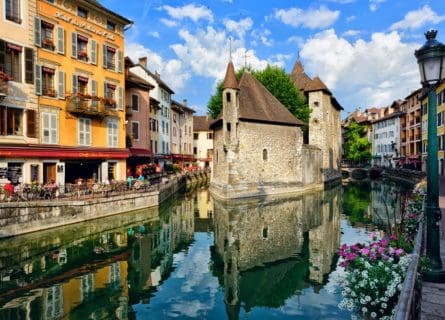
The Best Rhône-Alpes Food, Cheeses & French Wines to Match
October 25, 2021
Taste the Richness of Rhône-Alpes Cuisine: Explore Savory Specialties & Delectable Delights in our Ultimate Guide. Uncover Culinary Treasures Now!
By: Nicole Dickerson / Last updated: March 8, 2024
Estimated reading time: 12 minutes
Perched along the Atlantic coast in northwestern France, Normandy boasts a storied history, stunning landscapes, and novel culinary traditions. Though World War II buffs flock here annually to visit the infamous landing sites of the Allied invasion on D-Day, Normandy has a ton to offer for the gastronomically inclined traveler. Unlike Burgundy, Alsace, and other prominent French regions, Normandy is not renowned for wine production—instead, the region’s beverages of choice result from its leading agricultural product—apples. Normandy cultivates upwards of 800 varieties of apples, and the first orchards were planted here as early as the 8th century.
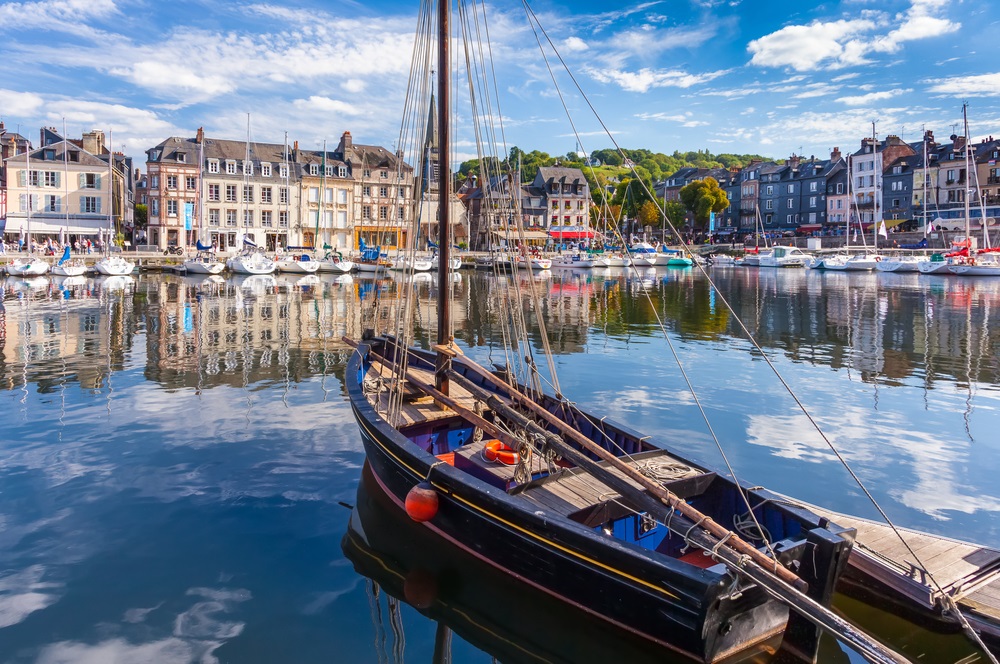
Guide to French Cuisine: Read more
In addition to being the culprit behind Normandy’s leading drinks like Calvados, cider, and Pommeau, apples also make their way into many Normandy recipes. Beyond this, noble fruit, cream, and seafood are two other prominent ingredients of Normandy Cuisine. The region’s 620km of coastline and stunning beaches provide a plethora of seafood to enjoy, including sole, mussels, oysters, scallops, and even lobster. Oysters, or huîtres in French, even have their own protected AOP designation in Normandy. Moreover, the region is France’s chief cultivator and exporter of mussels, scallops, and oysters.
As for the cream, it’s essential in several classic Normandy recipes, such as sole à la Normande, moules à la Normande, and poulet à la Normande. When a French recipe includes à la Normande in the name, it generally means that cream is featured in the recipe. Beyond a staple ingredient, the cream helps produce famous Normandy cheeses like Camembert, Pont-l’Évêque, and Neufchâtel. Plus, cream and butter from Isigny have been recognized as an AOP since 1986. They are beloved for their smooth texture and subtle hazelnut flavors. This delectable, multi-purpose cream is possible thanks to the free-grazing Norman cows influenced by the region’s sea air and marshy soils. Norman desserts also frequently feature one of several delicious variations of cream and apples together.
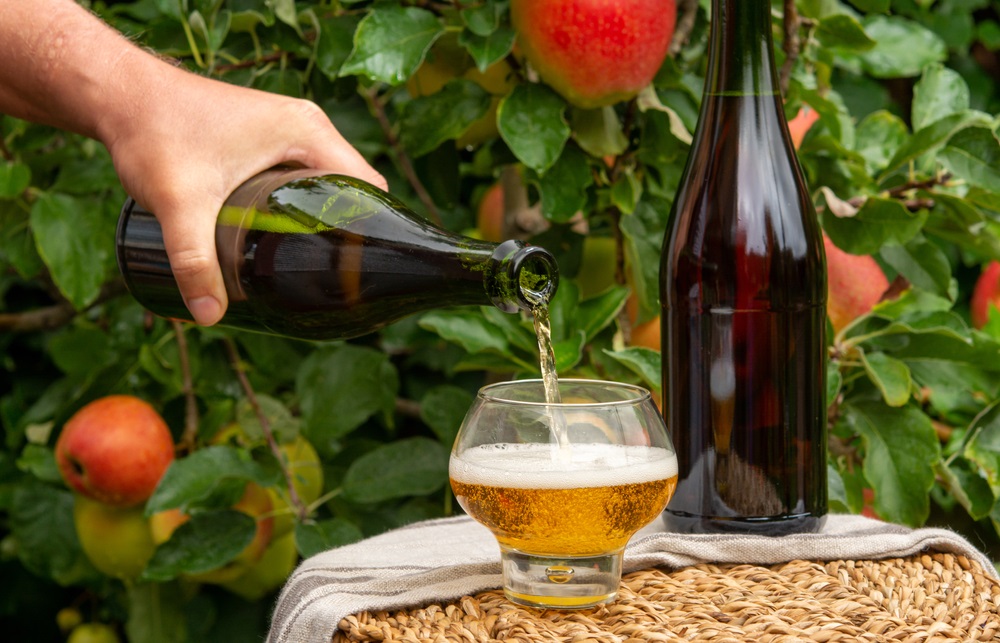
For l’aperitif in Normandy, reach for a local cider (cidre in French), as several options are available throughout the region. Made from local apples and perhaps pears, French cidre tastes like a sweet beer, depending on the designation. It comes in brut and doux styles; the latter is sweeter and has an alcohol content of 3-5% abv. The 40km Cider Route is fun to explore and a great way to discover local cideries in the Pays d’Auge subregion for tourists staying near Caen. Otherwise, look to these designations and styles for high-quality Normandy ciders:
Normandy is also famous for Calvados, a locally made apple brandy recognized as one of the world’s best spirits. Calvados has been integral to the region’s gastronomic culture for centuries. In France, it’s typically enjoyed as a digestif at the end of a meal or savored between courses to make room for more delectable Normandy Cuisine. When served between courses, it’s known as a ‘trou Normand,’ literally a Norman hole.
Guide to Calvados: Read more
Notably, Calvados is a key ingredient in Pommeau, a popular aperitif in Normandy. Pommeau is made from unfermented apple juice and Calvados aged in oak barrels. The aging process lasts at least eighteen months, imparting honey and vanilla flavors into Pommeau.
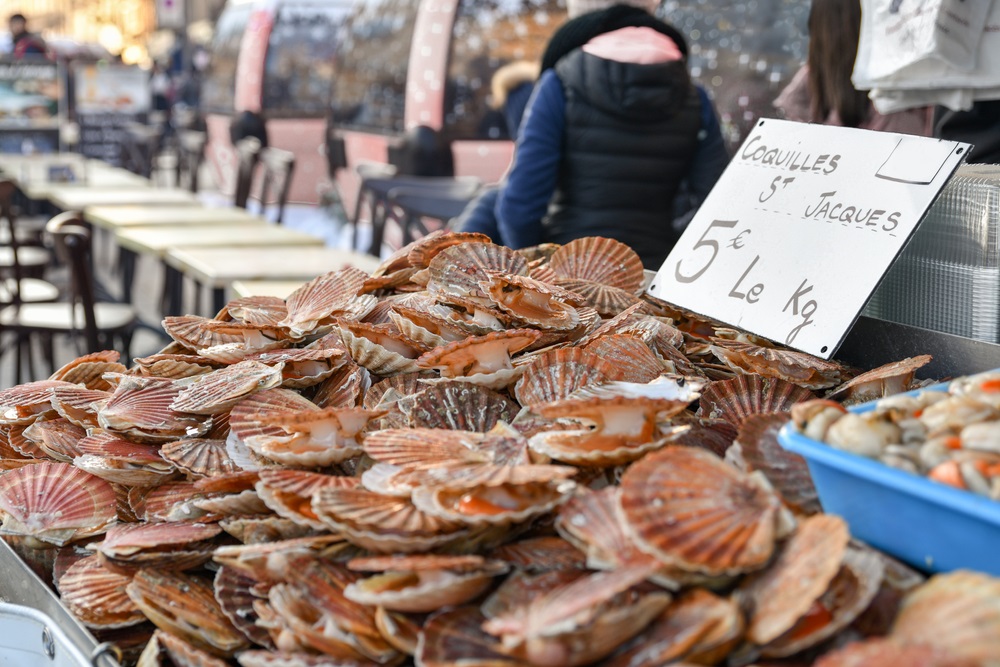
With seafood playing a prominent role in Normandy food culture, fresh oysters and mussels make the ideal entrée to kick off a meal. Oysters thrive along this Atlantic coast because the region has some of the strongest tides in Europe. Astonishingly, around one in every three oysters consumed in France comes from Normandy. The department of Le Manche in the lower half of the region cultivates 25-30% of France’s mussels. There’s no better place to have an ‘assiette de fruits de mer’ or a fresh plate of seafood. If not for the l’entrée, then for the main course as a seafood platter or plateau.
Muscadet makes for the ultimate wine pairing when savoring fresh oysters from the Atlantic. This white wine hails from the western Loire Valley near the Atlantic Ocean and the city of Nantes and is made from the Melon Blanc grape; Muscadet bursts with saline, citrus, and delicate green fruit aromas. Its refreshing acidity and light body are ideally paired with oysters and fresh seafood.
Coquilles Saint-Jacques are King Scallops harvested in Normandy from October through May. The region even hosts a scallop festival in autumn to kick off the season. The coquilles Saint-Jacques are prepared in their stunning shells with cream and breadcrumbs and then baked. Chardonnay is the ideal wine pairing for these creamy baked scallops; a Meursault Perrières Premier Cru from Burgundy offers a vibrant richness with notes of honey, florals, and a refreshing minerality.
A rustic gourmet product of Normandy Cuisine, andouille de Vire is a flavorful sausage made from the large intestines of pork. The pig intestines are cut into thin strips to make the sausage, then salted and marinated in brine for a few days. Once dried, they’re smoked over a beechwood fire for three weeks, then encased and boiled. Andouille de Vire is typically enjoyed cold, finely sliced, and served over bread. Alternatively, the sausage can be served warm over a salad with cooked apples.
Pair andouille de Vire with a Beaujolais cru like Morgon or Moulin-à-Vent. Made from Gamay, Beaujolais tends to be loaded with fresh red fruit flavors, making it an ideal match for savory sausage. Yet crus like Morgon and Moulin-à-Vent have greater concentration, slightly higher tannins, and better structure to match the bolder flavors of Andouille de Vire.
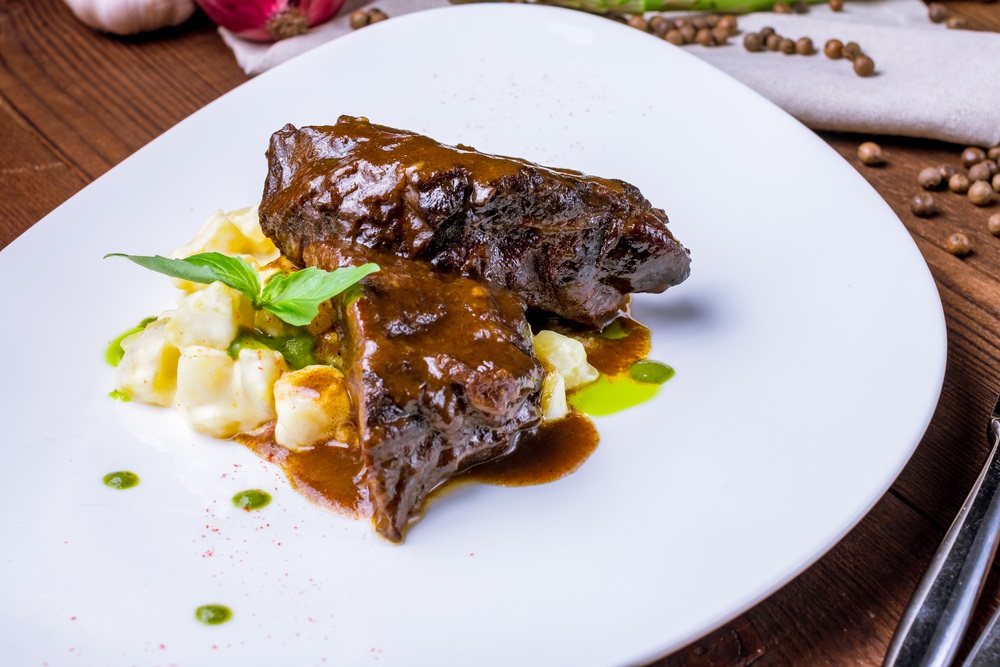
Joue de bœuf
This classic Normandy dish originated in the coastal town of Dieppe, though it can be found in restaurants spread across the coast. Marmite Dieppoise combines the quintessential flavors of Normandy into a seafood stew featuring mussels, scallops, fish, and crustaceans. The stew is flavored with butter, cider, a mixture of herbs in a bouquet garni, and crème fraîche.
For an irresistible wine pairing, try Chablis Grand Cru, whose high acidity contrasts with the creamy stew. While the ripe, concentrated citrus flavors of the wine complement the fresh seafood flavors in Marmite Dieppoise.
Normandy Cuisine delivers various mouthwatering recipes for moules or mussels. Moules à la Normande is a traditional preparation that serves the mussels in a luxurious sauce of onions, garlic, parsley, cider, butter, and cream. The aromatics are cooked first, then cider and the mussels are added. Once the mussels open, they’re removed. Next, the cream is added to the sauce and allowed to reduce for a more concentrated consistency. Finally, the mussels are tossed in the sauce and served with fries or bread.
Since moules à la Normande are made with a cream sauce, white wines with fresh flavors and high acidity or riper fruit flavors pair well with this dish. Try a richer, rounder aged Chenin Blanc from Anjou-Saumur or a dry sparkling Chenin Blanc from Vouvray.
Otherwise, try moules marinières steamed in a broth of white wine, garlic, onions, parsley, and other fresh herbs. The simple broth and fragrant aromatics allow the briny flavors of the mussels to shine. Match moules marinières with a vibrant Sauvignon Blanc from Sancerre. The wine’s refreshing acidity and elegant flavors of green apple, wet stones, and herbaceous notes are the ideal complement to moules marinières.
Agneau de pré salé, or meadow-salted lamb, comes from the mist-laden Bay of Mont Saint-Michel and the Cotentin Peninsula. The lamb grazes on fields or marshes that flood with salty ocean water near the coast. This grazing practice results in naturally salty lamb, garnering the meadow-salted lamb a protected AOP status. Consequently, agneau de pré salé has white flesh and a unique, delicate flavor. Preparations of this special meat typically avoid strong spices and sauces to preserve the lamb’s natural taste.
Therefore, agneau de pré sale requires a red wine pairing that won’t overpower its flavors. Pinot Noir from Nuits-Saint-Georges in Burgundy offers the perfect match with notes of red fruits and savory, earthy flavors to complement the lamb.
Tripes à la mode de Caen is an ancient tripe preparation from Caen in Normandy. It’s made with the four chambers of the cow’s stomach, cut into strips or squares, then layered into a traditional clay pot called a tripière. Cider, a glass of Calvados, root vegetables, garlic, and peppercorns are added to the tripière. Once the lid is placed on the clay pot, it’s sealed with a paste made from flour and water, then set in the oven. The tripe simmers for up to fifteen hours until tender and is typically served with boiled potatoes.
Savor tripes à le mode, de Caen, with a Merlot forward Saint-Émillion from Bordeaux. This structured red wine has a soft mouthfeel with dark berry fruit and black plum flavors to suit the tender tripe.
Joue de bœuf is a succulent beef cheek recipe enjoyed in Normandy Cuisine. The beef cheek reaches a melt-in-your-mouth consistency thanks to a lengthy braising process that traditionally could last up to two days. The cheeks of the Norman cow are cooked with cider, apples, carrots, onion, and an assortment of spices for flavor-packed comfort food in Normandy.
A tender beef dish like this calls for a rich red wine with plush tannins. Pair joue de bœuf with a Bordeaux blend from Saint-Estéphe, Pauillac, Saint-Julien, or Margaux. Cabernet Sauvignon dominates these red blends, which offer concentrated black fruit flavors and hints of cedar from oak aging.
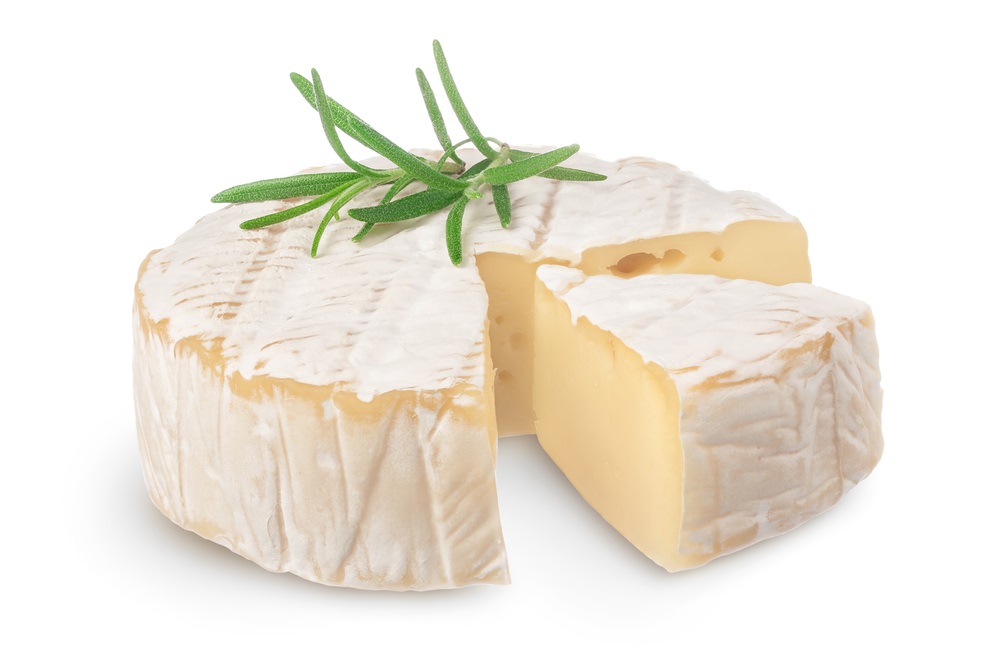
As one might expect from a French region renowned for its cream, Normandy Cuisine also features an abundance of cheeses. Most Normandy cheeses are made with cow’s milk and are a delightful match for local cider. However, a complex Champagne with toasty, nutty flavors, bright acidity, and orchard fruit flavors is a tasty wine pairing for many of these cheeses.
It is easily Normandy’s most famous cheese. It’s soft, lusciously creamy, and known for earthy, nutty, grassy, and even fruity flavors.
Neufchâtel has a trademark heart shape and bloomy white rind. This French cheese delivers delicate earthy mushroom notes. Historically, the girls of Pays de Bray gave Neufchâtel to English soldiers during the Hundred Years’ War.
A pungent washed-rind cheese is reminiscent of Epoisses in Burgundy. The flavor is much more sophisticated, rich, and nutty than the cheese’s stinky aromas suggest.
It is a soft, square-shaped cheese from Pays d’Auge whose earthy, chalky, delicate flavors come from the damp fields where the cows graze.
Brillat Savarin and Saint André are two decadently creamy, triple-cream cheeses with tangy, sweet flavors and buttery textures worth seeking out. The famously buttery, spreadable Boursin cheese, now produced internationally, was created in Normandy.
Guide to the Cheeses of Normandy: Read more
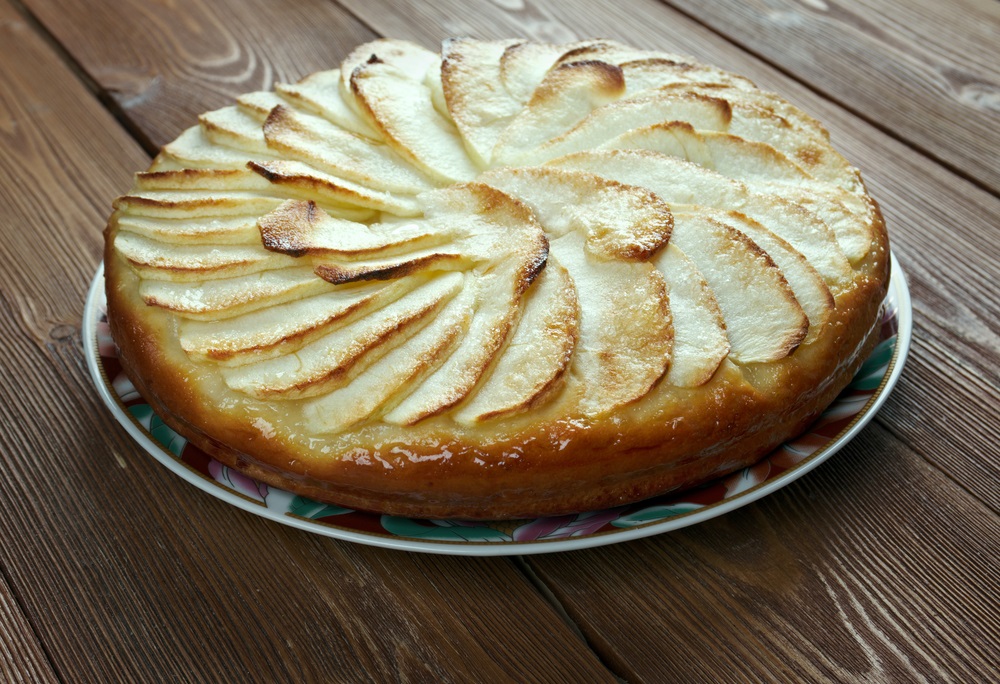
Tarte Normande, apple pie
Crêpes Mylene is a flambéed dessert from Normandy that’s adored throughout France. The crêpes are made with flour, milk, eggs, and a pinch of salt. Once cooked in butter, the crêpes are filled with sliced pears, rolled, and coated in orange juice, lemon juice, almonds, butter, sugar, and plum brandy. Finally, the crêpes are flambéed in plum brandy before serving.
Alternatively, try Crêpes Normandy, filled with apples browned in butter, cinnamon, and sugar. These are typically topped with luxurious whipped cream. A sweet, aromatic, vanilla-laden Sauternes makes a delicious pairing for either crêpes dessert.
Tarte Normande is made with shortcrust pastry (pâte brisée) and is filled with a sweet, almond-flavored custard infused with Calvados. The custard is topped with beautifully arranged slices of apples and baked until golden brown. To serve, tarte Normande is accompanied with a dollop of tangy crème fraîche. Pair tarte Normand with Crémant de Loire. Dominated by Chenin Blanc, these sparkling wines feature apples, quince, and honeysuckle flavors coupled with toasty hazelnut notes from lees aging.
Teurgole is an ancient Normandy recipe for French rice pudding, which is prepared by cooking rice in milk and sugar along with warm spices like nutmeg and cinnamon. Next, Teurgole is baked in traditional earthenware pots for a few hours, resulting in a dense consistency and caramelized crust. The Normans enjoy Teurgole with a glass of sweet cider and a local brioche bread called fallue.
If you would like us to customize an exclusive luxury tour, contact us and let us know your travel plans. We offer luxury food and wine tours for private groups of a mininium two guests. In addition, all of our private, chauffeured tours are available year-round upon request.

